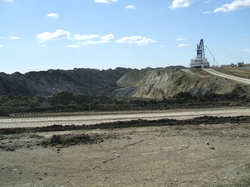As Americans retreat to cooler locales for the worst of the summer's heat, the Department of the Interior is on a listening tour about coal royalty reform. Interior manages coal on public lands for the public's best interest, which has been ill-served by the below-market prices attached to federal mineral leases for decades. This is no minor resource. The federal Bureau of Land Management currently oversees 310 active coal leases in 10 states, accounting for some 40% of coal produced in the US.
For many years, a loophole big enough to drive a dragline through has allowed coal companies to reduce or eliminate royalty payments. The federal royalty rate is set at 12.5% of the market price. However, current regulations allow coal companies to sell their coal at a discount to a marketing subsidiary and deduct large transportation costs - often over 50% of the value of the coal. The marketing subsidiary then sells the same coal at a markup and pays no royalty at all on the profits.
This is corporate welfare at its slickest. The coal companies point to the royalty they paid as evidence of their good citizenship, while pocketing the real money. It is high time Interior sewed shut this hole in the federal purse - but that is not what Interior proposes.
The current and proposed regulations allow miners to take federal coal - Taxpayer Coal, let's call it - at fire-sale prices. This is not just federal money. States and local governments rely on their half share of these royalties to pay for critical infrastructure and services like education.
Headwaters Economics, a non-partisan Montana natural resource think tank, estimates that coal companies are currently paying an effective royalty rate of 4.9% for Taxpayer Coal, by working the loophole. This state of affairs robs states and localities that bear the impacts of surface mining of the full compensation they should receive. It also unjustly enriches corporations that benefit directly from selling public resources.
The pushback from those corporations is that the public benefits from getting any return on minerals that would otherwise sit buried and unproductive. Higher royalties, the industry argues, would reduce the amount of coal mined. The answer is that if it is uneconomical to mine Taxpayer Coal today at reasonable royalty rates, then the public is far better served by leaving that coal where it is rather than giving it away.
In my home state of Montana in 2014, the state received $48.9 Million from the federal government as its share of coal royalties. The Headwaters analysis demonstrates that a royalty based on net market price would increase that payment by 1.93%, even without any cap on transportation deductions. If we also cap transportation deductions at 50% - already an outrageously high amount - that increase would be 3.17%.
The benefit to the state treasury in Montana would total only a few million a year, but in neighboring Wyoming, the gain would be in the hundreds of millions. Alabama, Colorado, Kentucky, New Mexico, North Dakota, and Utah would also receive public monies that are currently lining the pockets of the richest people on Earth. This is one loophole it should be a no-brainer to close. More information is available from Plains Justice.


